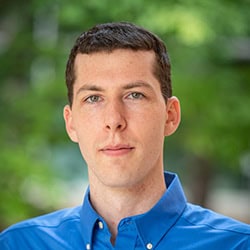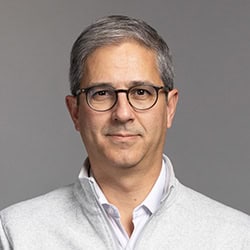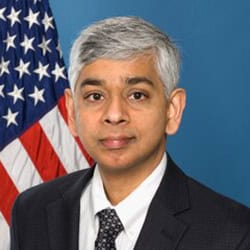
Seminar Series (AE 585)
Meets every Thursday at 3:00 p.m. in the Boeing Lecture Hall, Room 1109, FXB Building.
Fall 2024 Seminars

September 5, 2024
Richard French
Vice President, BD & Strategy, Space Systems
A broad update from Rocket Lab including recent results from NASA CAPSTONE mission to the moon and Winnebago mission entering the world’s first commercial payload
Abstract:
This talk will provide a broad update on Rocket Lab’s progress as an end-to-end space company and include recent results from key missions.
As the global leader in dedicated small launch, Rocket Lab continues to make progress with the Electron launch vehicle and the Neutron medium lift launch vehicle. An update will be provided with recent results including launches supporting hypersonics test in a new suborbital configuration for Electron and the beginning of a successful series of hot fire tests of the Archimedes engine for Neutron.
As a new prime contractor leveraging a vertically integrated space systems capability, Rocket Lab continues to make progress in challenging satellite missions with a range of spacecraft models. An update will be provided on recent results including the NASA CAPSTONE mission to the moon and a challenging mission that successfully returned the first commercial payload from space on the Winnebago mission for Varda Space Industries. An overview of the NASA ESCAPADE mission to Mars, the Scorpius mission under the Space Development Agency’s Tranche 2 Transport Layer-Beta program, and the tactically responsive Victus Haze mission under Space Systems Command’s Space Safari will also be provided.
Bio:
Richard French leads business development and strategy for Rocket Lab’s space systems division, providing end-to-end mission services and on-orbit operations with the company’s line of spacecraft and high-end satellite components including reaction wheels, star trackers, radios, solar power, separation systems, software, and more.
Richard spent over a decade at NASA’s Jet Propulsion Laboratory, where he led development of the Techstars Starburst Space Accelerator program and managed technology partnerships with industry in the Office of Space Technology. He also spent two years on detail to NASA Headquarters in Washington, D.C. as a Staff Technologist in the Space Technology Mission Directorate, leading development of the Tipping Point and Announcement of Collaborative Opportunity solicitations. Richard’s earlier career includes service as an engineer on various NASA missions, including being awarded the NASA Honors Early Career Public Achievement Medal for his work as a lead mechanical systems engineer on the Soil Moisture Active Passive mission, and helping to land the Curiosity Rover on Mars as a member of the Mars Science Laboratory entry, descent, and landing systems engineering team.
Richard holds a Masters degree in Space Systems Engineering and a Bachelors degree in Aerospace Engineering, both from the University of Michigan.

September 12, 2024
Jae-Sung Bae
Professor, Dean of Academic Affairs
A Study on Mid-Air Separation-Reintegration Technology for a Fixed Wing Parent and Child UAVs
Abstract:
The modern UAV systems requires an automatic aerial recoveries of fixed-wing UAVs. Recently, the UAV research team of Korea Aerospace University (KAU) have studied the mid-air separation-reintegration technology for a fixed wing parent and a child UAV. The present seminar introduces the concepts of a parent and child UAV systems and mid-air separation, rendezvous, docking, and reintegration technologies for this parent and child UAV systems of KAU. This study includes theoretical approaches for guidance and control and much flight test of the parent and child UAV system.
Bio:
Jae-Sung Bae received his B.S. degree in Aeronautical and Mechanical Engineering from Korea Aerospace University in 1996 and his M.S. degree in Aerospace Engineering from KAIST in 1998. He then received his Ph.D. in Aerospace Engineering from KAIST in 2002. Dr. Bae is currently a Professor of Department of Aerospace Engineering, and Dean of Academic Affairs at Korea Aerospace University in Goyang-City, Korea. His main research interests include aeroelasticity, vibration and control, UAVs, Morphing UAVs, and SPUAV (Solar Powered UAV).

September 19, 2024
Joseph Breeden
Attitude Controls Systems Engineer
Safety-Critical Control for Space Systems using Control Barrier Functions
Abstract:
Barrier Functions (also called Barrier Certificates) are a method of certifying the safety of a control system, namely that a closed-loop system will never exit a specified “safe set”. Barrier Functions are naturally extended to Control Barrier Functions to provide for both a safety certificate and a constructive method of designing nonlinear control laws to satisfy one or more safety constraints. Engineers commonly account for all these constraints together in a Quadratic Program (called a CBF-QP), which is assumed or proven to be always feasible. This talk introduces the method of CBF-QPs for safety-critical control and discusses considerations for using CBF-QPs in space systems, including provable input constraint satisfaction, unique actuators, and challenging and/or uncertain dynamics. Results will be shown for satellite attitude control systems, asteroid proximity operations, and low Earth orbit debris avoidance.
Bio:
Joseph Breeden received his B.S. in Aerospace Engineering and Mathematics from the University of Maryland, and his M.S. and PhD in Aerospace Engineering from the University of Michigan. Joseph’s research at Michigan focused on applications of control barrier functions to provably-safe autonomy for space mission concepts. Joseph’s research interests are primarily in nonlinear control systems and multi-agent systems. Joseph received Outstanding Student Paper Awards from both the IEEE Technical Committee on Aerospace Control and the IEEE Control Systems Society, and was the 2024 recipient of the Pierre T. Kabamba Award for Excellence in Control Systems. Joseph is currently an Attitude Controls System Engineer at NASA Goddard Space Flight Center, where he has developed control systems for the On-Orbit Servicing Assembly and Manufacturing, Global Precipitation Measurement, and Lunar Ice Cube missions, and currently works on several CubeSats.

September 26, 2024
Daniel M. Israel
Los Alamos National Laboratory
Statistical models for transition to turbulence
Abstract:
Many reduced-order models for laminar-turbulent transition exist, but they are uniformly difficult to incorporate into standard CFD codes. Transition sensitized RANS models, seek to modify long-established statistical models for turbulence so that they accurately capture transition. These models rely on ad-hoc empirical functions which are tuned to limited experimental data. This talk will discuss why the prediction of transition is so hard, and why it is so important, for applications ranging from cars and wings to supernovae. Preliminary data shows that a new approach, much better grounded in the flow physics, performs well for predicting transition in flows with multiple materials.
Bio:
Daniel Israel received his B.S. in Mechanical Engineering from Cornell University, and a Ph.D. in Aerospace Engineering from the University of Arizona. He joined Los Alamos National Laboratory as a post-doc, and then remained as a staff member. At LANL, Dr. Israel has worked in modeling and simulation of turbulence and transition in flows with material mixing, reduced-order modeling, verification and validation, epidemiology, numerical methods, and high-performance computing. For many years he ran LANL’s Computational Physics Student Summer Workshop. He and his family recently moved to Ann Arbor to be part of a new collaboration between LANL and the University of Michigan.

October 3, 2024
Dr. Kevin G. Bowcutt
Principal Senior Technical Fellow & Chief Scientist of Hypersonics, The Boeing Company
Flying at the Edge of Space: The Challenges and Opportunities of Hypersonic Flight
Abstract:
Efforts to develop technologies and systems enabling hypersonic flight have beenongoing since the late 1940’s. During this time substantial advancements have been made in hypersonic air-breathing propulsion systems, high-temperature structural materials and thermal protection systems, and advanced vehicle design methods and tools. Taken together, these advancing technologies are moving mankind ever closer to achieving routine hypersonic flight, which will enable dramatically faster military missions and global transportation, and substantially more affordable space transportation. This presentation will describe the key technical drivers, critical technologies and unique challenges of designing and developing vehicles to fly at hypersonic speed. Also described will be a vision for the future of hypersonic flight and what Boeing has done to turn that vision into reality.
Bio:
Dr. Kevin G. Bowcutt is a Principal Senior Technical Fellow & Chief Scientist of Hypersonics for Boeing with 42 years of experience. He is an AIAA Fellow, a Fellow of the Royal Aeronautical Society, and a member of the National Academy of Engineering. In 2021 he was selected by Texas A&M to be a Fellow of the Hagler Institute of Advanced Study. He holds BS, MS and PhD degrees in aerospace engineering from the University of Maryland. Dr. Bowcutt is an internationally recognized expert in hypersonic aerodynamics, propulsion integration, and vehicle design and optimization. Notable accomplishments include developing the viscous- optimized hypersonic waverider, flight testing scramjets by launching them from a light gas gun, supporting NASA’s X-43A scramjet flight test program, originating and optimizing the design of the X-51A scramjet demo vehicle, supporting the Space Shuttle Columbia accident investigation by simulating wing aero-thermal-structural failure, leading Boeing’s contributions to the HIFiRE international hypersonic flight experiment program, and leading Boeing’s reusable hypersonic airplane design investigation. Dr. Bowcutt has taught a capstone course on hypersonic vehicle design at several universities. Dr. Bowcutt leads Boeing’s advanced design and technology development efforts for hypersonic missiles, airplanes and space-planes.

October 10, 2024
Juan J. Alonso
Vance D. and Arlene C. Coffman Professor; also James and Anna Marie Spilker Chair of the Department of Aeronautics & Astronautics
Validation of Aircraft Noise Modeling by Large-scale Data Collection and AEDT Prediction
Abstract:
The MONA project (Metroplex Overflight Noise Analysis) was started to provide real-time and objective data, analyses, and reports to key stakeholders and policy makers to mitigate the noise impacts of the deployment of new NextGen procedures. The system (a) collects and archives air traffic data using a network of antennae and ADS-B receivers, (b) analyzes noise impacts using a variety of metrics, (c) visualizes resulting large-scale datasets, and (d) uses a network of sound-level monitors (SLMs) to validate and enhance the quality of our noise predictions. The work has also resulted in the full automation of the FAA’s AEDT (Aviation Environmental Design Tool) noise prediction capabilities so that we can create large-scale datasets with hundreds of thousands of flights and noise events in order to draw statistically-significant observations and conclusions. The presentation will discuss the results of one such validation study for arrival operations into San Francisco International Airport (SFO) as well as initial efforts to leverage big datasets to create new noise models that are more accurate than the ones currently available in AEDT.
Bio:
Juan J. Alonso is the Vance D. and Arlene C. Coffman Professor of Aeronautics and Astronautics at Stanford University and the James and Anna Marie Spilker Chair of the Department. Prof. Alonso is the founder and director of the Aerospace Design Laboratory (ADL) where he specializes in the development of high-fidelity computational analysis and design methodologies to enable the creation of realizable and efficient aerospace systems. He is keenly interested in the sustainability of the commercial aviation enterprise. He is the author of over 300 technical publications on the topics of computational aircraft and spacecraft design, multi-disciplinary optimization, fundamental numerical methods, and high-performance parallel computing. During the period spanning 2006-09, Prof. Alonso was the Director of the NASA Fundamental Aeronautics Program in Washington, DC. In that position he was responsible for the entire portfolio of aerospace vehicle and vehicle technology research for the agency in the subsonic rotary wing, subsonic fixed wing, supersonic, and hypersonic regimes, with particular emphasis on the energy and fuel efficiency of the aviation enterprise and its environmental impact. He is the recipient of several AIAA Best Paper Awards, the NASA Exceptional Public Service Medal, the NASA ARMD Associate Administrator Award, and the AIAA Stanford Chapter Professor of the Year award (8 times). Prof. Alonso has served in the NASA Advisory Council, the Secretary of Transportation’s Future of Aviation Advisory Committee, the FAA Administrator’s Management Advisory Council, and as an Independent Expert in the ICAO/CAEP fuel burn, noise, and emissions technology goals evaluation. He is also the CTO and co-founder of a new startup company, Luminary Cloud, that is attempting to revolutionize multi-physics simulations through GPU computing. Prof. Alonso earned his Ph.D. in Mechanical and Aerospace Engineering at Princeton University and his B.S. degree at the Massachusetts Institute of Technology.

October 17, 2024
Dr. Venkateswaran (Venke) Sankaran
United States Air Force
Foundational Research in the Age of Digital Engineering
Abstract:
The talk will provide an overview of current research activities in the Aerospace Systems Directorate of the Air Force Research Lab (AFRL) with a focus on current digital engineering activities. In particular, foundational research studies in modeling & simulation of combustion and propulsion systems will be presented, including emerging areas of importance such as data-driven methods, model reduction, uncertainty quantification, and digital twins. Examples of applications of these methods to rocket propulsion, scramjet combustion, and rotating detonation engines will be discussed.
Bio:
Dr. Venke Sankaran is the Chief Scientist for the Aerospace Systems Directorate, Air Force Research Laboratory, Wright–Patterson Air Force Base, Ohio. He guides the execution of the directorate’s $500M science and technology portfolio in turbine engines, high–speed systems, power & controls, air vehicles, rocket propulsion, and systems analysis. Prior to joining AFRL, he worked as research faculty at Penn State, University of Tennessee and Purdue University and as an research scientist at the US Army’s Aero Flight Dynamics Directorate. He is the author of more than 200 technical papers and has been actively involved in research programs involving rocket propulsion, aerodynamics, hydrodynamics and plasmas.